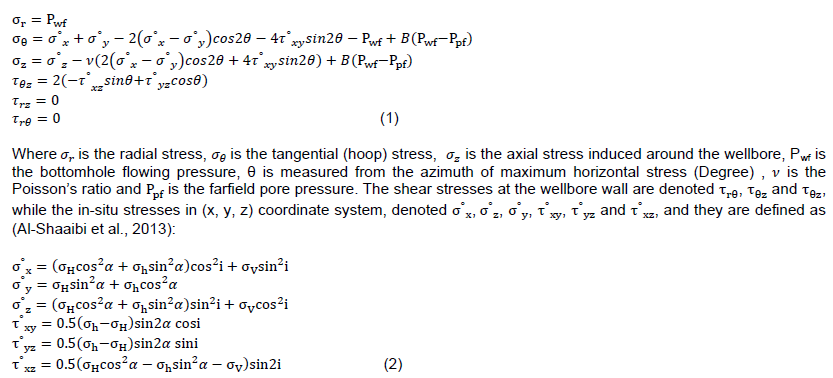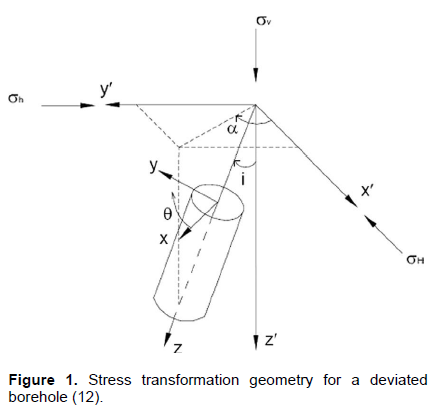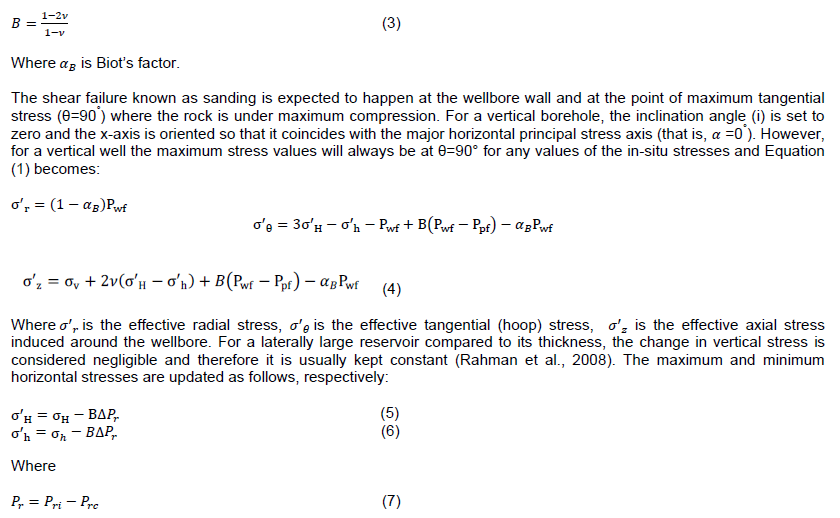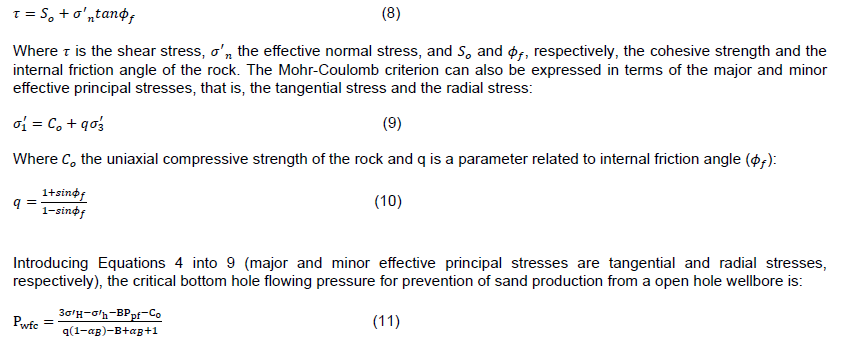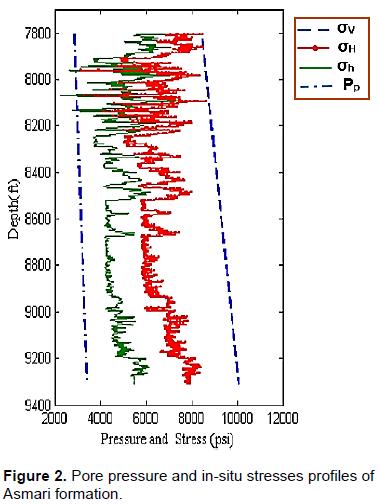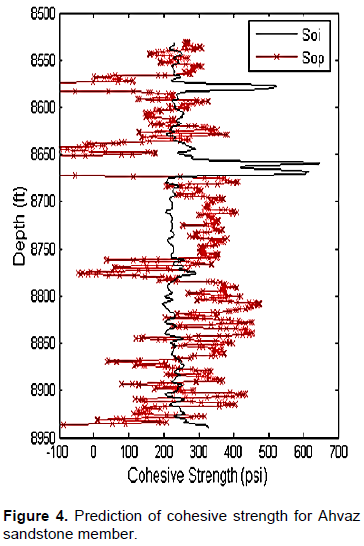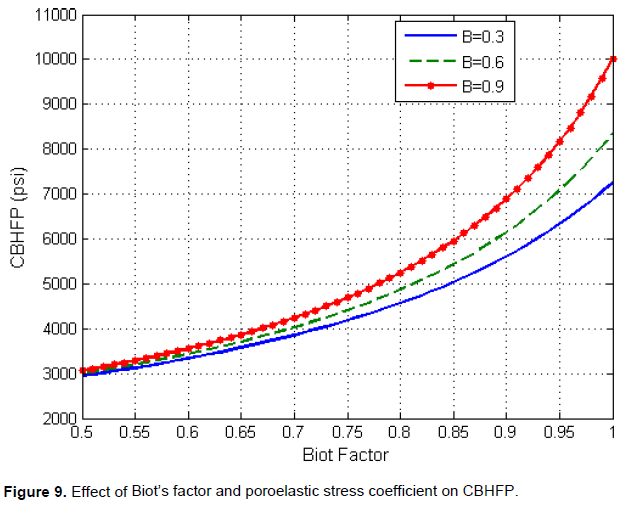ABSTRACT
Sand production is a prevalent problem during oil and gas production from weakly consolidated or unconsolidated formations. It can erode downhole equipment and surface facilities, cause pipeline blockage, leakage and damage casing and generate additional need for sand disposal. Decision for appropriate sand control strategy requires engineering analysis of the key parameters affecting sand production to evaluate timing and severity of sanding over the life of field conditions. This paper presents the effects of reservoir and geomechanical parameters including well trajectory, poroelastic stress coefficient, Biot’s factore, maximum horizontal stress, horizontal stress anisotropy ratio, cohesive strength and Uniaxial Compressive Strength (UCS) on sand production from openhole wells. The results indicated that the critical bottomhole flowing pressure increases with increasing the poroelastic stress coefficient, Biot’s factor, maximum horizontal stress and horizontal stress anisotropy ratio, but decreases with increasing the cohesive strength and UCS of rocks. Furthermore, the results show that the wellbore inclination and azimuth have a significant role in sanding potential during production. Also, it is concluded that in normal stress regime the critical bottom hole flowing pressure of a horizontal borehole is greater than the vertical borehole, so the vertical boreholes have less potential for sanding than the horizontal boreholes and almost all the deviated wells. Accurate prediction of the conditions for sand production is critical to the design of cost effective completion.
Key words: Sand production, geomechanical parameters, well trajectory, biot’s factor, horizontal stress.
Production of oil and gas from hydrocarbon-bearing reservoirs can result in a reduction of the reservoir pore pressure (formation pressure) unless pressure support is provided from a gas cap or an aquifer. A reduction in the reservoir pressure, in turn, results in a reduction in the stresses acting within the reservoir. This stress-depletion response is known from simple theoretical calculations and has been observed in field data. Wells drilled into depleting fields will experience this change in the stress acting within the field. This has important implications for well design as an increasing number of wells are being designed as openhole or barefoot completions. Well design is also becoming increasingly customised in order to minimise the number of wells required to drain a field.
Consequently, large horizontal well sections are drilled with multilateral branches - several horizontal well sections drilled from one producing well. An important aspect of the design for these customised and multilateral wells is the openhole stability over the lifetime of the field, which is dependent on how the reservoir stresses will change with depletion (Addis, 1997).
In the petroleum industry, the term “sand production” refers to the production of solid particles together with the formation fluids from depleted reservoirs. This phenomenon is common mainly in weak sandstone reservoirs and is a possible consequence of the degradation of the mechanical properties of the rock surrounding the wellbore caused by drilling, completion, and production operations particularly, during the production phase, the decrease of pore pressure causes a concentration of stresses around the wellbore and the perforation tips which, in turn, can lead to the failure of the rock. When the right conditions are met, e. g. production rates sufficiently high, then the failed rock can be mobilized and the fluid flow can drag to the surface grains, particles or aggregates of the damaged rock (Volonté et al., 2010).
Sanding can erode downhole equipment and surface facilities, cause pipeline blockage, leakage and damage casing due to formation subsidence, lead to more frequent well intervention and workovers, and generate additional need for sand disposal (Addis, 1997). Decision for appropriate sand control strategy requires engineering analysis of the key parameters affecting sand production to evaluate timing and severity of sanding over the life of field conditions.
Sand production mechanisms can be summarized into the following points (Wang et al., 2005): (1) Shear failure induced by fluid pressure drawdown can lead to the breaking of sand grain bonds and the alteration of the material’s mechanical properties; (2) Tensile failure caused by high hydrocarbon production rates can lead to dilation of solid skeleton and the loss of solid particles mechanical interactions through disaggregation; (3) High stresses due to completion cause the formation to fail (in compression) whereas fluid viscous drag forces bring the failed materials from the perforation tunnels into the wellbore.
There are many factors that must be considered to obtain a comprehensive understanding of how and why sand production occurs and such factors include: (1) Geological factors. (2) Rock composition. (3) Mechanical factors. (4) Drilling practices. (5) Production operations (Joseph et al., 2012).
Tao et al. (2008) reported that as the flow rate is increased, the wellbore pressure decreases and the effective tangential stress in the elastic zone increases. On the other hand, the effective stresses in the plastic zone decrease with increasing flow rates due to the increase in the pore pressure gradient.
Increasing the flow rate can initiate sanding, therefore the critical production rate at which the cavity becomes unstable should be determined during oil and gas production in weakly consolidated or unconsolidated formations.
Morita et al. (1987) by separating the effect of well pressure and local pressure gradient around the cavity, proposed an analytical approach to study the effects of many parameters on sand production. It was pointed out that the following parameters may affect sand production: (1) Boundary loads such as well pressure and in-situ stresses; (2) Fluid flow induced force which is dependent on such factors as flow rate, permeability, viscosities of fluids, relative permeability for multiphase flow and fluid saturation, (3) rock deformation character, (4) rock strength character, (5) perforation cavity geometry and shot density, (6) cyclic loading history.
Sanding onset prediction involves stress calculation at cavity (including wellbore or perforation tunnel) surface. Even though a numerical model, such as finite element model, is more general, analytical or semi-analytical models may be more convenient and easier to use under special conditions. Besides, an analytical model is always useful to verify numerical models. In petroleum engineering, the vertical/horizontal wellbore, perforation tunnel and their adjacent formation are often approximated as thick-walled hollow cylinder. Using this approximation, it can be able to obtain an analytical or semi-analytical solution for the near wellbore/perforation tunnel stress state and use it in sand production prediction (Yi, 2003).
Drilling the wellbore or creating any cavity like perforations, changes the stress pattern in the medium around the cavity (Dai et al., 2014). Increase of drawdown augments effective stresses in an interval around the wellbore. This is attributed to the fact that pore pressure recovers much more slowly compared to total stresses. Therefore, shear stresses increase around the cavities once higher drawdowns are used. In this respect, acts depletion very similarly to drawdown in increasing shear stresses around the cavities. Shear failure induced by fluid pressure drawdown takes place once shear stresses exceed limit shear strength of the intact rock and can lead to the breaking of sand grain bonds and the alteration of the material’s mechanical properties. Shear failure mechanism is mainly active around the cavities where two major criteria are fulfilled. First, shear stresses are very high and second, differential deformations are possible (Nouri et al., 2003).
Sanding related studies can go back to the 1920’s, and before the 1970’s, most studies were associated with sand control, and then the interests shifted to the determination of onset of sand production and a Mohr-Coulomb (M-C) type shear failure was initially postulated (Luo et al., 2012).
The objective of this paper is to present the sensitivity analyses of reservoir and geomechanical parameters on the sand production from open hole wellbores.
STRESS CONCENTRATION AROUND A WELLBORE AT PRODUCTION CONDITION
The stress concentration around a well drilled in an isotropic, elastic medium under anisotropic in-situ stress condition (Maximum and minimum horizontal stresses are different) is described by the Kirsch equations. The general expressions for the stresses at the wellbore wall for a deviated well in the production situation are Fjær et al. (2008):
Where and are the maximum and minimum horizontal stresses, respectively, is the vertical stress, i is wellbore inclination and is the azimuth angle due to the maximum horizontal stress ( ) direction (Degree). Figure 1 shows the stress transformation system in a deviated borehole where is the rotation angle around the z′-axis (measured from the x′-axis) and i is the rotation angle around the y′-axis (measured from the z′-axis) and is the poroelastic stress coefficient defined as (Al-Shaaibi et al., 2013):
and and are the maximum and minimum horizontal stresses at current production condition, respectively. and are the initial and current reservoir pressures, respectively.
SANDING ONSET PREDICTION MODEL
To predict the well pressure at which sanding will occur the stress equations at the borehole wall must be compared against the failure criterion. The stress equations based on linear poroelastic constitutive laws for deviated and vertical wellbores were introduced earlier. These equations will be inserted in to the Mohr-Coulomb criterion to obtain the critical wellbore pressure for sanding onset (Pw) (Al-Shaaibi et al., 2013).
The Mohr-Coulomb criterion is the simplest and most commonly used strength criterion for geomaterials. The Mohr-Coulomb criterion can be expressed in terms of shear stress and effective normal stress on the shear plane as follows (Zhang et al., 2010):
CONSTRUCTION OF MECHANICAL EARTH MODEL
A Mechanical Earth Model (MEM) is an explicit description of the mechanical properties of the reservoir and overburden formations, including rock strength and elastic properties, the state of in-situ stresses and their direction as well as pore pressure. It forms the basis for any geomechanical analysis, such as wellbore stability analysis, sanding prediction evaluation, hydraulic fracture design, mechanical characterization of fractured formation, fault seal evaluation, reservoir compaction and subsidence evaluation, etc. Therefore, the reliability of sanding prediction analysis largely relies on robustness of the MEM (Mohiuddin et al., 2009). The field and laboratory data required for this study are provided from a number of production wells in one of fields located in the south west of Iran.
Calculation of rock mechanical properties
The mechanical properties of formations and dynamic elastic constants of subsurface rocks can be derived from the measurement of elastic wave velocities and density of the rock. Sonic logging and waveform analysis provide the means for obtaining continuous measurements of compressional and shear velocities. These data, in conjunction with a bulk density measurement, permit the in-situ measurement and calculation of the mechanical properties of the rock. The elastic moduli relationships, in terms of elastic wave velocities (or transit times) and bulk density can be calculated from following equations (Alipour and Mirzaahmadian, 2010):
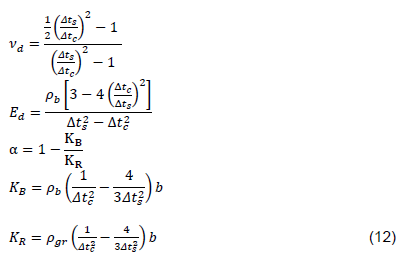
Where is the dynamic Poisson’s ratio , Ed is the dynamic Young’s modulus (psi), Δts is shear wave travel time (ft/s), Δtc is compressional wave travel time (ft/s), kB is dynamic bulk modulus (psi), KR is the rock modulus (psi), ρb is the bulk density (gr/cm3), ρgr is the grain density (gr/cm3), and “b” is the constant coefficient which is equal to 1.34*1010. For the Asmari formation of mentioned oilfield, an equation developed for estimation of shear wave travel time by Nabaei et al. (2009) was used:
Where ε1 and ε2 are strains due to tectonic forces in maximum and minimum directions and considered 1 and 1.5, respectively. Based on drilling information pore pressure gradient is estimated 0.365 psi/ft. Figure 2 shows the stresses and pressure profiles in the study area. The study area is associated with a normal faulting stress regime, where the maximum principal stress is vertical stress ( h < H < v).
Uniaxial compressive strength
The uniaxial compressive strength (UCS) is defined as following correlation based on rock lithology and core measurements for Asmari formation, which is described by an exponential relationship between uniaxial compressive strength (psi) and sonic wave travel time (ft/s) (Khaksar et al., 2009):
Effect of cohesive strength
The behavior of sand free envelope plot based on the Critical Bottom Hole Flowing Pressure (CBHFP) of wellbore for series of cohesive strength from 290 to 1370 psi at the depth of 8700 ft are shown in Figure 3. Table 1 shows the geomechanical and reservoir properties of target depth. It can be seen that, as the cohesive strength of target sand is increased, the amount of sand free drawdown and depletion becomes larger and if the value of cohesive strength reaches 1370 psi, no sanding risk considered for this well at mentioned depth and was termed Idealized cohesive strength (ICS). Figure 4 show the values of initial and promoted cohesive strength (Soi and Sop) for prevention of sand production at current production condition as function of depth for Ahwaz sandstone member of Asmari formation.
Effect of uniaxial compressive strength
The behavior of sand free envelope plot for series of uniaxial compressive strength (UCS) from 1122 to 8000 psi at the depth of 8700 ft is shown in Figure 5. It can be seen that, As the UCS of target sand is increased, the amount of sand free drawdown and depletion becomes strength (IUCS). Figure 6 show the values of initial and promoted uniaxial compressive strength (UCSi and UCSp) for prevention of sand production at current production condition as function of depth for Ahwaz sandstone member.
Effect of well trajectory
Figure 7 shows the two dimensional plot of critical bottom hole flowing pressure of the wells with different inclination and azimuth in Ahvaz sandstone member. The vertical axis is the wellbore inclination in degree, horizontal axis is the azimuth in direction of maximum horizontal in degree and the colored regions indicate the CBHFP. It is concluded that in normal stress regime the CBHFP of a horizontal borehole is greater than the vertical borehole, so the vertical boreholes have less potential for sanding than the horizontal boreholes and almost all the deviated wells. In this case, the best drilling trajectory is a well with inclination of 30° and azimuth of 90° (Zare-Reisabadi et al., 2012). It is also obvious that, drilling parallel to the minimum horizontal stress direction is the best trajectory in this case. In addition, it shows that the CBHFP or sanding potential is highly sensitive to the inclination in all direction or azimuth.
Effect of horizontal stress anisotropy
Figure 8 show the effects of maximum horizontal stress and horizontal stress anisotropy ratio (HSAR) on CBHFP. The horizontal stress anisotropy ratio is defined as:
As Figure 8 depicts, an increase in maximum horizontal stress leads to increase in the CBHFP in an invariable HR. It can be seen that increasing HSAR tends to increase in the CBHFP.
Effect of Biot’s factor and poroelastic stress coefficient
Figure 9 indicates the influences of the Biot’s factor and poroelastic stress coefficient on CBHFP. It can be concluded that the CBHFP increases by increasing of the poroelastic stress coefficient in particular Biot’s factor. Also in a fixed poroelastic stress coefficient an increase in Biot’s factor increases the CBHFP.
This paper presents the effects of reservoir and geomechanical parameters including well trajectory, poroelastic stress coefficient, Biot’s factor, maximum horizontal stress, horizontal stress anisotropy ratio, cohesive strength and uniaxial compressive strength (UCS) on sand production from openhole wells. The results indicated that:
1. In normal stress regime the critical bottom hole flowing pressure of a horizontal borehole is greater than the vertical borehole, so the vertical boreholes have less potential for sanding than the horizontal boreholes and almost all the deviated wells. In this case, the best drilling trajectory associated with inclination of 30° and azimuth of 90°.
2. The critical bottomhole flowing pressure increases with increasing the poroelastic stress coefficient, Biot’s factor, maximum horizontal stress, horizontal stress anisotropy ratio, but decreases with increasing the cohesive strength
and UCS of rocks.
The authors have not declared any conflict of interests.
REFERENCES
|
Abdideh M, Fathabadi MR (2013). Analysis of stress field and determination of safe mud window. J. Petrol Explor. Prod. Technol. 3:105-110.
Crossref
|
|
|
|
Addis MA (1997). Reservoir Dedletion and its Effect on Wellbore Stability Evaluation. Int. J. Rock Mech. Min. Sci. 34:3-4.
|
|
|
|
|
Alipour TV, Mirzaahmadian Y (2010). Investigation of Sand Production Onset: A New Approach Based on Petrophysical Logs, SPE 150529, In: Proceedings of the SPE Annual Technical Conference and Exhibition, Louisiana, 15–17 February.
|
|
|
|
|
Al-Qahtani M, Rahim Z (2001). A Mathematical Algorithm for Modeling Geomechanical Rock Properties of the Khuff and Pre-Khuff Reservoirs in Ghawar Field. SPE 68194, In: Proceedings of the SPE Annual Technical Conference and Exhibition, Bahrain, 17-20 March.
Crossref
|
|
|
|
|
Al-Shaaibi S, Al-Ajmi A, Al-Wahaibi Y (2013). Three dimensional modeling for predicting sand production. J. Petrol. Sci. Eng. 103:348-363.
Crossref
|
|
|
|
|
Dai ZP, Stauffer H, Carey JW, Middleton RS, Lu Z, Jacobs JF, Hnottavange-Telleen K, Spangle L (2014). Pre-site characterization risk analysis for commercial-scale carbon sequestration. Environ. Sci. Technol. 48:3908-3915.
Crossref
|
|
|
|
|
Fjær E, Holt RM, Horsrud P, Raaen AM, Risne A (2008). Petroleum Related Rock Mechanics, 2nd edition Elsevier, Amsterdam.
|
|
|
|
|
Joseph A, Akubue LC, Ajienka JA, Oriji AB (2012). Sanding Prediction using Rock Mechanical Properties (A Parametric Study), SPE 162945, In: Proceedings of the Nigeria Annual International Conference and Exhibition held in Abuja, Nigeria, 6–8 August.
Crossref
|
|
|
|
|
Khaksar A, Fang Z, Kayes T, Salazar T, Rahman R (2009). Rock strength from core and logs: Where we stand and ways to go. In: Proceedings of the EUROPEC/EAGE Annual Technical Conference and Exhibition, Amsterdam, June 8–11.
Crossref
|
|
|
|
|
Luo W, Xu S, Torabi F (2012). Laboratory Study of Sand Production in Unconsolidated Reservoir, SPE 158619, In: Proceedings of the SPE Annual Technical Conference and Exhibition, San Antonio, Texas, USA, 8-10 October.
|
|
|
|
|
Mohiuddin MA, Najem NM, Al-Dhaferi YR, Bajunaid HA, Al-Khafji F (2009). Geomechanical Characterization of a Sandstone Reservoir in Middle East—Analysis of Sanding Prediction and Completion Strategy. SPE 120049. In: Proceedings of the SPE Annual Technical Conference and Exhibition, Bahrain, 15–18 March.
|
|
|
|
|
Morita N, Whitfill DL,Fedde OP, Levik TH (1987). Parametric Study of Sand Production Prediction: Analytical Approach, SPE 16990, Presented at the at the 62nd SPE Annual Technical Conference and Exhibition, Dallas, TX, 27-30 September.
|
|
|
|
|
Nabaei N, Shahbazi K, Shadravan A, Moazzeni MR (2009). Artificial Neural Network Modelling Enhances Shear Wave Transit Time, SPE 12158, In: Proceedings of the SPE Annual Technical Conference and Exhibition, Kish Island, 16-20 November.
|
|
|
|
|
Nouri A, Vaziri H, Belhaj H, Islam B (2003). Comprehensive Approach to Modeling Sanding During Oil Production. SPE 81032, In: Proceedings of the SPE Annual Technical Conference and Exhibition, Trinidad, West Indies, 27–30 April.
Crossref
|
|
|
|
|
Perchikolaee SR, Shadizadeh SR, Shahryar K, Kazemzadeh S (2010). Building a Precise Mechanical Earth Model and its Application in Drilling Operation Optimization: A Case Study of Asmari Formation in Mansuri Oil Field. SPE 132204, In: Proceedings of the SPE Annual Technical Conference and Exhibition, 8–10 June.
|
|
|
|
|
Rahman K, Khaksar A, kayes R, Helix K (2008). Minimizing Sanding Risk by Optimizing Well and Perforation Trajectory Using an Integrated Geomechanical and Passive Sand-Control Approach. SPE 116633, In: Proceedings of the SPE Annual Technical Conference and Exhibition, Colorado, USA, 21–24 September.
|
|
|
|
|
Tao Q, Birchwood R, Ghassemi A (2008). Poroelastoplastic Analysis of Factors Controlling Sand Production from aHemispherical Cavity, ARMA 08-306. In: Proceedings of the 42nd US Rock Mechanics Symposium, San Francisco, June 29-July 2.
|
|
|
|
|
Volonté G, Scarfato F, Brignoli M (2010). Sand Prediction: A Practical Finite-Element 3D Approach for Real Field Applications, SPE 134464, In: Proceedings of the SPE Annual Technical Conference and Exhibition, Florence, Italy, 19–22 September .
Crossref
|
|
|
|
|
Wang HF (2000). Theory of linear poroelasticity, Princeton University Press, Princeton.
|
|
|
|
|
Wang J, Wan RG, Settari A, Walters A (2005). Prediction of Volumetric Sand Production and Wellbore Stability Analysis of a Well at Different Completion Schemes, ARMA/USRMS 05-842. In: Proceedings of the Rock Mechanics for Energy, Mineral and Infrastructure Development in the Northern Regions, Anchorage, Alaska, June 25-29.
|
|
|
|
|
Yi X (2003). Numerical and Analytical Modeling of Sanding Onset Prediction. Texas A&M University (Ph.D. thesis).
|
|
|
|
|
Zare-Reisabadi MR, Kaffash A, Shadizadeh SR (2012) Determination of optimal well trajectory during drilling and production based onboreholestability. Int. J. Rock Mech. Min. Sci. 56:77-87.
Crossref
|
|
|
|
|
Zhang L, Cao P, Radha K (2010). Evaluation of rock strength criteria for wellbore stability analysis. Int. J. Rock Mech. Min. Sci. 47(8):1304-1316.
Crossref
|
|
